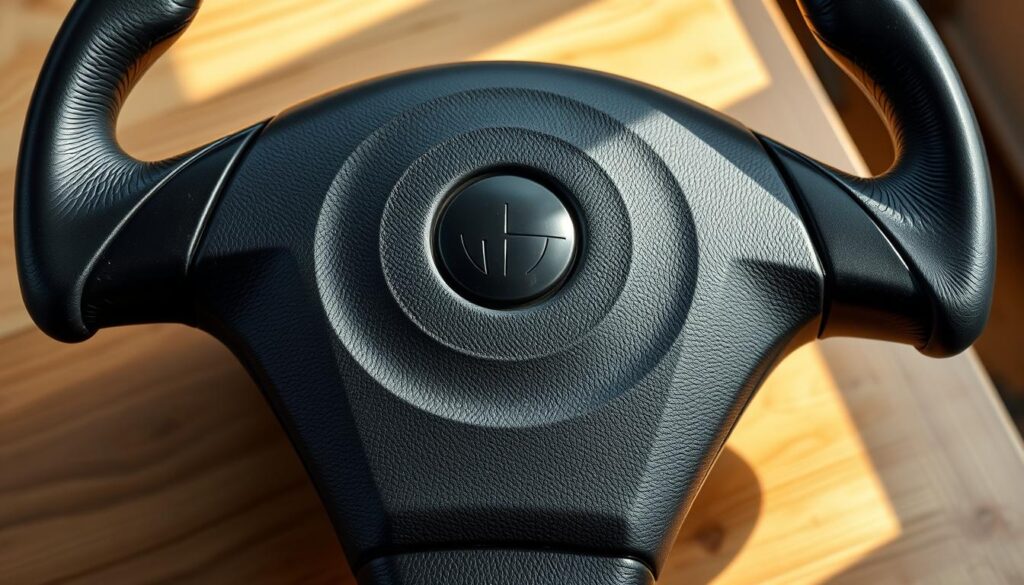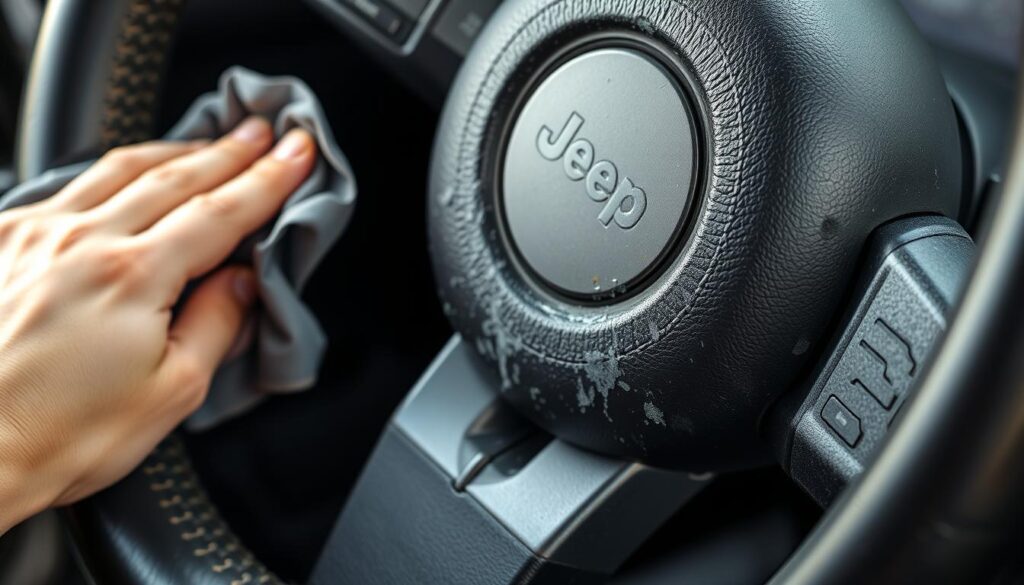Surprising fact: nearly 6 in 10 drivers report a tacky leather surface after regular use — often within a year — caused by oil, sweat, and grime that collect over time.
We know the frustration. Your leather steering can go from smooth to tacky fast. Natural oils from hands mix with sunscreen and dirt. Heat and sun speed the problem, and the wrong product makes it worse.
In this guide we explain why your steering feels tacky and how a simple, safe process restores the original wheel feel. We focus on gentle leather care — a pH-balanced wash first, soft agitation, careful drying, and light conditioning only when needed.
We’ll also note tweaks for coated or faux leather and tips to prevent sun damage. Follow our step-by-step approach and you’ll protect quality leather, improve grip, and keep your car interior comfortable for years.
Key Takeaways
- Oils, sweat, and grime cause tacky leather over time.
- Always clean thoroughly before you condition; less is more.
- Use pH-balanced leather products and a soft brush for safe removal of residue.
- Sun and heat speed up stickiness—protect with UV-safe care.
- Faux leather needs gentler, different products than quality leather.
Why is my Jeep steering wheel sticky? Common causes specific to Wrangler use
Hands, sunscreen, and heat often turn a smooth leather grip into a gummy nuisance. We see the same pattern in many cars: oils from skin mix with lotions and food residue. That combo forms a film that traps dirt and grime over time.
Natural oils, sweat, sunscreen, and food residue
Daily contact transfers natural oils and sweat from hands to the surface. Sunscreen and lotions add a film that attracts dirt. Left without proper care, the leather steering surface feels tacky and unpleasant.
Wrong products and over-conditioning
Household cleaners or heavy conditioners leave greasy residue. Over-conditioning without a proper wash pushes grime deeper and causes long-term damage. We recommend a pH-safe approach later in the guide.
Sun, heat, and humidity
Hot, dry sun bakes oils out of leather and causes cracking. Humid climates let moisture sit, then evaporate, leaving a filmy residue. Faux coatings can break down and go shiny-sticky faster than genuine leather.
| Cause | Signs | Quick fix |
|---|---|---|
| Natural oils & sweat | Tacky feel, darkened areas | Wash with pH-balanced cleaner; dry |
| Lotion or sunscreen residue | Filmy surface, slippery spots | Targeted degrease, then condition lightly |
| Over-conditioning or wrong product | Greasy layer, trapped dirt | Remove residue, use lighter product |
| Sun/heat or humidity | Cracking, shiny coating, persistent film | Shade, UV protection, regular light care |
Bottom line: some stickiness is normal with time, but small habits—clean hands, smart products, and shade—keep the leather steering wheel feeling smooth and safe. In the next section we show how to start removing sticky residue step by step.
What you need before removing sticky steering wheel residue

Let’s assemble a few simple tools that prevent damage and speed results. We’ll focus on safe supplies for leather care in your car interior. Choose a pH-balanced leather cleaner and avoid household solvents.
Core kit:
- Two clean microfiber towel — one damp, one dry; using microfiber towel correctly keeps residue from smearing.
- A quality leather cleaner made for auto surfaces — not an all-purpose spray.
- A small, soft horse-hair brush to lift grime from the grain without scratching.
- Optional: mild soapy water for an initial wipe and a UV-safe, non-greasy conditioner to apply later.
Always test under the hub or a hidden spot first. That tells you if the product will fade color or harm stitching.
Work in the shade. That gives you control over dwell time and helps remove dirt without over-wetting the leather steering. Avoid alcohol, ammonia, or bleach — they dry and weaken the material.
cleaning sticky steering wheel on Jeep Wrangler: step-by-step to get rid of stickiness

Start in the shade and work methodically so the surface doesn’t dry too fast. Test a hidden spot first to confirm colorfastness and product safety.
How to get residue off: gentle wash, then targeted leather cleaner
Lightly dampen a microfiber towel for a first pass — this lifts loose grime without soaking seams. For the main pass, apply a pH-balanced leather cleaner to the towel, not directly to the surface. Wipe in sections and focus on high-touch zones.
Deep-clean technique
Use a soft horse-hair brush to work stubborn spots in small circles following the grain. Wipe away the slurry with a damp microfiber towel to remove dirt and oils. Repeat only as needed.
Dry, inspect, and condition
Dry fully with a fresh towel so no product lingers. Then apply a pea-sized amount of non-greasy leather conditioner to a cloth. Rub lightly, buff within a minute, and avoid over-saturating the material.
Adjustments for faux materials
For coated or faux surfaces, skip heavy conditioners. Use a gentle interior cleaner more often and avoid alcohol, ammonia, or bleach — these break down coatings fast.
- Quick tip: clean hands extend results and protect the finish.
Sticky steering wheel repair and prevention tips that last
Protecting a leather surface starts with small choices you make before each drive. We focus on practical fixes that keep the rim comfortable and extend life over time.
Daily habits that save time and prevent damage
Wash or wipe your hands before you get behind the wheel. Oils, sweat, and dirt transfer fast. Avoid heavy lotions after applying sunscreen.
Use a sunshade and park in shade when possible. That reduces heat and limits sun damage to the leather.
Routine care that protects leather long term
Make a simple schedule: quick monthly wipe with a pH-safe cleaner and seasonal conditioner. A light leather conditioner keeps the feel without greasiness.
In hot or humid climates, increase frequency to combat humidity and extra sweat. Faux surfaces need gentler, more frequent care and less conditioner.
- Consider a steering wheel cover if the surface is aging—fit one after a full service clean to protect and restore appearance.
- Keep a small kit in the car for fast touch-ups. That stops dirt build-up and reduces future damage.
Conclusion
A quick, reliable routine will get your grip back and protect the finish for months. Start with a pH-balanced cleaner, agitate gently with a soft brush, then dry fully. Apply a light conditioner only if you have quality leather.
Test first in a hidden spot and work section by section so the product lifts grime and oils without changing color. For coated or faux materials, skip heavy conditioners and use gentle cleaners more often.
Protect from sun damage with a shade, wipe hands before driving, and schedule monthly care. Small, steady steps stop sticky residue, extend the life of your car interiors, and keep the steering wheel feeling right.
FAQ
Why is my Jeep Wrangler steering wheel sticky?
Several things cause tackiness — natural skin oils and sweat, sunscreen and hand lotions, food or drink residue, plus grime from dirty hands. Heat and humidity common in many U.S. regions speed breakdown of finishes. Overuse of heavy conditioners or the wrong products can leave a tacky film, too.
How do natural oils and sunscreen create that tacky feel?
Oils and sunscreens build up in the leather’s pores. Over time they mix with dust and dead skin, forming a greasy layer that feels sticky. Sun and heat worsen the problem by softening leather finishes and attracting more grime.
Could a leather conditioner make the problem worse?
Yes — using too much or using a product not made for automotive leather can leave residue. Some conditioners contain silicones or oils that create a tacky surface once they sit on the leather. Always use a quality, pH-balanced leather product and apply sparingly.
What tools and products do we need before removing residue?
Gather a soft microfiber towel, a pH-balanced leather cleaner safe for car interiors, a soft-bristle brush for gentle agitation, and a small test spot to try the product first. Keep water nearby for rinsing the towel.
What’s the safest first step to remove sticky residue?
Test your cleaner on an inconspicuous area. If it’s safe, wipe the surface with a slightly damp microfiber towel to remove loose dirt. Follow with the leather cleaner applied to the towel — not directly to the material — and work in light, circular motions.
How do we deep-clean the leather without causing damage?
Use a soft-bristle brush with the pH-balanced cleaner to loosen embedded grime. Work gently and avoid scrubbing hard. Wipe away residue with a clean, damp microfiber towel. Let the surface air-dry completely before any conditioning.
When should we apply leather conditioner after cleaning?
Only after the surface is fully dry. Apply a small amount of a reputable automotive leather conditioner — thin, even layers — and buff lightly. Avoid over-saturating; less is better to prevent tackiness returning.
What if the rim isn’t real leather — how do we adjust?
For faux leather or vinyl, use cleaners and protectants specifically labeled for those materials. They often require milder cleaners and different conditioners. Always test first and avoid oil-based products that can cause surface breakdown.
What daily habits help prevent the problem from coming back?
Keep hands clean and dry before driving, avoid heavy lotions or greasy sunscreens, and remove food or drink from the cabin when possible. Use a sun shade to reduce heat exposure and protect the finish.
How often should we clean and condition to maintain the feel?
Light cleaning every few weeks helps. Do a deeper clean monthly if you drive often. Condition lightly every season — more often in hot, humid climates. Adjust frequency based on usage and visible buildup.
Are steering wheel covers a good long-term solution?
Yes — a quality cover protects the original material from oils, sweat, and sun damage. Choose a breathable, well-fitted cover that won’t trap moisture. Covers are also an easy, affordable way to restore a comfortable grip without chemical treatments.
How quickly should we act when we notice tackiness?
Act as soon as possible. The longer oils and grime sit, the deeper they penetrate and the harder they are to remove. Prompt, gentle cleaning limits damage and preserves the leather’s look and feel.
Recent Posts
Is your car idling rough when cold? Learn why does my car idle rough when cold in winter USA and find DIY fixes.
Step-by-Step Guide: Changing Wiper Blades on Volvo S60 (USA)
"Changing wiper blades on Volvo S60 (USA model) made easy. Follow our DIY guide to replace windshield wipers and resolve common Volvo wiper problems."

